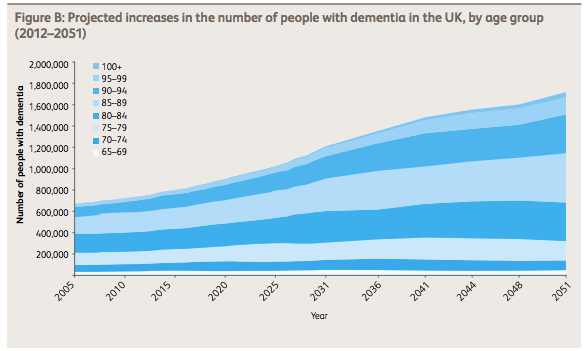
How I spent my Time2Give
Giving Back: How I became involved in a study into using the Internet of Things in healthcare using Cisco’s Time2Give Programme
For the last few weeks, I have been lucky enough to see first-hand some of the benefits that technology advances can bring to healthcare. Thanks to Cisco’s ‘Time2Give’ program which allows employees to take 5 days per year out of the office to volunteer, I have had the opportunity to learn about an area of healthcare which is of particular concern to many. Dementia affects more and more people each year, and while the effects of the disease can be difficult enough for the person to cope with, friends and family are also deeply affected. And dementia diagnoses are on the increase.
According to the 2014 Dementia UK report from the Alzheimer’s Society the number of people in the UK with dementia is forecast to grow to more than 1 million by 2025 and to more than 2 million by 2051.

‘Figure B: Projected increases in the number of people with dementia in the UK, by age group (2012–2051)’ in the 2014 Dementia UK report: https://www.alzheimers.org.uk/download/downloads/id/2323/dementia_uk_update.pdf
The Technology Integrated Health Management (TIHM) project is a two year study led by Surrey and Borders Partnership NHS Foundation Trust, funded by the Department of Health, NHS England and Innovate UK, which is looking at new approaches for helping people with complex, long term health conditions, including dementia.
The project is intended to help the team understand the benefits that the Internet of Things (IoT) can bring to people with dementia and their carers. Unobtrusive sensors, including movement and door monitors, which help to highlight unusual patterns of activity, are installed in the person’s home. The person can also record general information about how they are feeling each day, and take readings of their own, such as blood pressure and hydration level measurements.
The project team are collecting and analysing the data collected, which will help them understand whether this kind of technology will help people with dementia live at home more safely, with fewer emergency hospital visits. This trial is the first of its kind in the UK, and taking place in my home county of Surrey. In the space of only a few weeks I have had the opportunity to learn more about dementia and Alzheimer’s in particular, to become a ‘dementia friend’, and to understand how the potential of IoT technology is being harnessed.
I have visited the Living Lab at the University of Surrey, and seen how thoughtfully and carefully the study has been designed. The needs of the person with dementia and their carer are being taken into account by ensuring that the sensors are unobtrusive and easy to use. And the technical team are bringing all the information together into a dashboard that makes analysis as easy as possible, while ensuring an extremely high level of data security.
The study is currently in the recruiting phase, and the team are looking for 1400 people with mild to moderate dementia and their carers who live in Surrey and NE Hants to take part.
If you or someone you know are affected by Alzheimer’s, learn more here.
2 Comments




This is really great and very inspiring. How did you go about doing this exactly? Id like to know more….
Angela, this is great! I am a Dementia Friends Champion (https://www.dementiafriends.org.uk/WEBArticle?page=what-is-a-champion) and it’s wonderful to see Cisco’s community’s involvement and support.